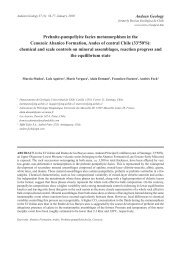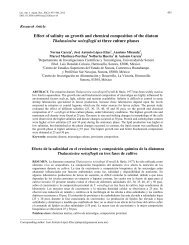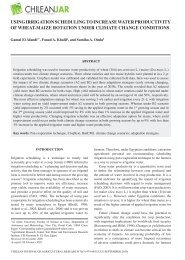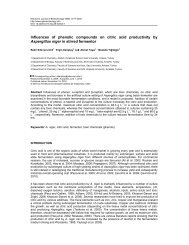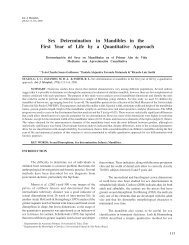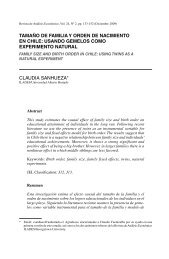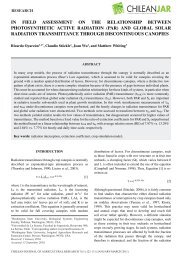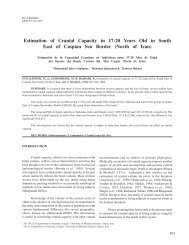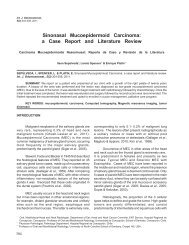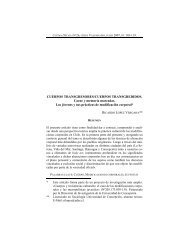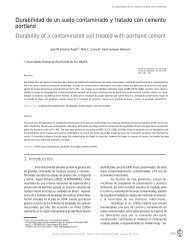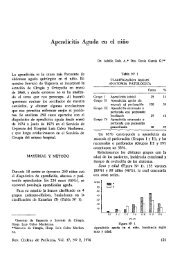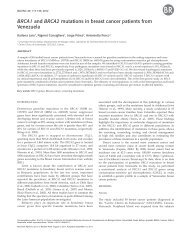nutrients balances in beef cattle production systems and - SciELO
nutrients balances in beef cattle production systems and - SciELO
nutrients balances in beef cattle production systems and - SciELO
You also want an ePaper? Increase the reach of your titles
YUMPU automatically turns print PDFs into web optimized ePapers that Google loves.
40<br />
Nutrients <strong>balances</strong> <strong>in</strong> <strong>beef</strong> <strong>cattle</strong> <strong>and</strong> their impact on the environment, Alfaro et al.<br />
NUTRIENTS BALANCES IN BEEF CATTLE PRODUCTION<br />
SYSTEMS AND THEIR IMPLICATIONS FOR THE<br />
ENVIRONMENT<br />
Balances de nutrientes en sistemas de producción de carne del sur de chile y sus<br />
implicancias para el medioambiente<br />
M. Alfaro 1 , F. S. Salazar 1 ; O. Oenema 2 ; S. Iraira 1 ; N. Teuber 1 ; L. Ramirez 1 <strong>and</strong><br />
D. Villarroel 1<br />
1 National Institute for Agricultural Research (INIA), Remehue Research Centre. P.O. Box<br />
24-O, Osorno, Chile. Correspond<strong>in</strong>g author: malfaro@<strong>in</strong>ia.cl<br />
2 Wagen<strong>in</strong>gen University <strong>and</strong> Research Center, ALTERRA. PO Box 47, NL-6700,<br />
Wagen<strong>in</strong>gen, The Netherl<strong>and</strong>s.<br />
ABSTRACT<br />
The ma<strong>in</strong> <strong>in</strong>puts <strong>and</strong> outputs of nitrogen (N) <strong>and</strong> phosphorus (P) <strong>in</strong> soils <strong>and</strong> swards under<br />
typical Southern Chilean conditions were determ<strong>in</strong>ed between 2004-2005 <strong>and</strong> 2006-2007<br />
to establish soil <strong>and</strong> field gate N <strong>and</strong> P <strong>balances</strong> under different immediate stock<strong>in</strong>g rates<br />
(63 <strong>and</strong> 191 anim ha -1 d -1 ) <strong>and</strong> field slope treatments (4 <strong>and</strong> 12%). Treatments received<br />
67.5 <strong>and</strong> 40 kg N <strong>and</strong> P ha -1 yr -1 as <strong>in</strong>organic fertilizer. The ma<strong>in</strong> N <strong>and</strong> P <strong>in</strong>put to the soil<br />
<strong>balances</strong> was N m<strong>in</strong>eralization (304 kg ha -1 yr -1 ) <strong>and</strong> <strong>in</strong>organic fertilizer (62 <strong>and</strong> 69% for<br />
N <strong>and</strong> P, respectively). The ma<strong>in</strong> output for all treatments was plant uptake (95% <strong>and</strong><br />
100% on average for N <strong>and</strong> P, respectively). The N <strong>and</strong> P apparent use efficiency was<br />
high (>95%). The ma<strong>in</strong> N <strong>and</strong> P <strong>in</strong>put to field gate <strong>balances</strong> was <strong>in</strong>organic fertiliser (>95%),<br />
while animal <strong>production</strong> had a m<strong>in</strong>or effect on N <strong>and</strong> P export. The soil <strong>balances</strong> ranged<br />
from -303 up to +58 <strong>and</strong> from -3 up to +20 kg of N <strong>and</strong> P ha -1 yr -1 . Field N <strong>and</strong> P gate<br />
budgets ranged between -309 up to +58 <strong>and</strong> from -8 up to +20 kg of N <strong>and</strong> P ha -1 yr -1 ,<br />
respectively, <strong>in</strong>dicat<strong>in</strong>g a potential soil degradation <strong>in</strong> areas with low nutrient <strong>in</strong>puts <strong>in</strong><br />
<strong>in</strong>organic fertiliser <strong>and</strong> an overaccumulation <strong>in</strong> areas with low dry matter <strong>production</strong> of<br />
the grassl<strong>and</strong>, which <strong>in</strong> turn can lead to environmental constra<strong>in</strong>s. This should be especially<br />
considered for dairy <strong>systems</strong>, which are more <strong>in</strong>tensively managed.<br />
Key words: stock<strong>in</strong>g rate, field slope, graz<strong>in</strong>g, nutrient budget.<br />
RESUMEN<br />
Las pr<strong>in</strong>cipales entradas y salidas de nitrógeno (N) y fósforo (P) en un suelo y pradera<br />
típica de las condiciones del sur de Chile fueron determ<strong>in</strong>adas en 2004/05 y 2006/07 para<br />
establecer <strong>balances</strong> de suelo y puerta bajo diferentes cargas animales (63 <strong>and</strong> 191 anim<br />
ha -1 d -1 ) y pendiente topográfica (4 y 12%). Los tratamientos recibieron 67,5 y 40 kg N y<br />
P ha -1 año -1 como fertilizante <strong>in</strong>orgánico. Las pr<strong>in</strong>cipales entradas de N y P al suelo fueron<br />
la m<strong>in</strong>eralización de N (304 kg ha -1 año -1 ) y la fertilización <strong>in</strong>orgánica (62 y 69% para N<br />
y P, respectivamente). Las pr<strong>in</strong>cipales salidas para todos los tratamientos fue la extracción<br />
de las plantas (95% y 100% en promedio para N y P, respectivamente). La eficiencia de<br />
uso de N y P fue alta (>95%). El pr<strong>in</strong>cipal <strong>in</strong>greso de N y P al balance de puerta fue el
R.C.Suelo Nutr. Veg. 9 (1) 2009 (40-54) J. Soil Sc. Plant Nutr. 9 (1) 2009 (40-54)<br />
41<br />
fertilizante <strong>in</strong>orgánico (>95%), mientras que la producción animal tuvo un efecto despreciable<br />
sobre la exportación de N y P. Los <strong>balances</strong> de suelo variaron entre -303 y +58, y desde<br />
-3 a +20 kg de N y P ha -1 año -1 . Los <strong>balances</strong> de puerta variaron entre -309 y +58, y entre<br />
-8 y +20 kg de N y P ha -1 año -1 , respectivamente, <strong>in</strong>dic<strong>and</strong>o un potencial de degradación<br />
de suelo en áreas con bajo <strong>in</strong>greso de nutrientes en fertilizantes <strong>in</strong>orgánicos y una<br />
sobreacumulación en áreas con bajo nivel de producción de materia seca, lo que puede<br />
resultar en restricciones medioambientales. Esto debería considerarse especialmente en<br />
sistemas de producción de leche, que son más <strong>in</strong>tensivamente manejados.<br />
Palabras claves: carga animal, pendiente topográfica, pastoreo, <strong>balances</strong> de nutrientes.<br />
INTRODUCTION<br />
The Lake Region of southern Chile has<br />
suitable climatic conditions <strong>and</strong> soil types<br />
for <strong>cattle</strong> <strong>production</strong>. Consequently, 56% of<br />
the national <strong>cattle</strong> herd is concentrated <strong>in</strong><br />
this maritime temperate climatic region,<br />
grazed on natural <strong>and</strong> improved pastures.<br />
These <strong>cattle</strong> produce 70% of the country’s<br />
milk <strong>and</strong> 50% of the meat (INE, 2007). In<br />
addition, 80% of Chile’s dairy farmers are<br />
located <strong>in</strong> this region <strong>and</strong> they own 67% of<br />
the l<strong>and</strong> dedicated to dairy <strong>production</strong> used<br />
nationally (Anrique, 1999).<br />
Livestock <strong>production</strong> use nitrogen (N)<br />
<strong>and</strong> phosphorus (P) as <strong>in</strong>organic fertilizer,<br />
be<strong>in</strong>g these elements the ma<strong>in</strong> cost of<br />
fertilizer application. In grassl<strong>and</strong>s, N-<br />
fertilization range between 0-200 kg N<br />
ha -1 yr -1 <strong>and</strong> P-fertilization range between<br />
35-90 kg P ha -1 yr -1 , with possible<br />
implications for N <strong>and</strong> P positive surpluses<br />
<strong>in</strong> these livestock <strong>systems</strong>. Also, <strong>and</strong> N <strong>and</strong><br />
P <strong>in</strong>puts <strong>in</strong> animal feed has <strong>in</strong>creased over<br />
the last ten years <strong>in</strong> the area, because of the<br />
use of greater stock<strong>in</strong>g rates (Alfaro <strong>and</strong><br />
Salazar, 2005), which <strong>in</strong> turn, dem<strong>and</strong>s a<br />
greater nutrient <strong>in</strong>put per area unit. Despite<br />
this, Chilean livestock <strong>systems</strong> can be<br />
considered as extensive if compared with<br />
European, New Zel<strong>and</strong>er or Northeamerican<br />
productive <strong>systems</strong>, where <strong>in</strong>puts <strong>in</strong> fertilizers<br />
<strong>and</strong> animal feed overcome <strong>in</strong>puts compared<br />
to our conditions.<br />
Nutrient <strong>balances</strong> have been widely used<br />
as tools for predict<strong>in</strong>g the potential<br />
environmental impact of livestock <strong>systems</strong><br />
(i.e. Ledgard et al., 1999) <strong>and</strong> their<br />
contribution to farm<strong>in</strong>g <strong>and</strong> policy decisions<br />
has <strong>in</strong>creased <strong>in</strong> the past few years.<br />
Nevertheless, this methodology has<br />
restrictions as they can not be used alone<br />
as safe guidel<strong>in</strong>es for farmers or scientists,<br />
because of the need to account for <strong>in</strong>dividual<br />
items (<strong>in</strong>puts, outputs), <strong>in</strong> both absolute <strong>and</strong><br />
relative terms (Van Noordwijk, 1999). In<br />
European countries N <strong>and</strong> P <strong>balances</strong> usually<br />
show surpluses of these <strong>nutrients</strong>, with<br />
potential negative environmental impacts<br />
(i.e. Jarvis, 1993; Haygarth et al., 1998).<br />
In Chile, there is little <strong>in</strong>formation on N<br />
soil <strong>and</strong> farm budgets (Dumont <strong>and</strong> Alfaro,<br />
1998; Nuñez et al., 2008), with no published<br />
data for N budgets for closed grazed <strong>systems</strong><br />
or P budgets <strong>in</strong> grazed areas. The objective<br />
of our study was to establish N <strong>and</strong> P soil<br />
<strong>and</strong> field gate <strong>balances</strong> <strong>in</strong> grassl<strong>and</strong> <strong>systems</strong><br />
of Southern Chile, with different immediate<br />
stock<strong>in</strong>g rates <strong>and</strong> different field slopes.<br />
The results of this study will help to validate<br />
this tool for Chilean livestock <strong>systems</strong> <strong>and</strong><br />
will contribute to focus the research on<br />
environmental aspects related to livestock<br />
<strong>production</strong> under local conditions.<br />
MATERIALS AND METHODS<br />
Experimental site<br />
A field experiment at INIA Remehue<br />
(40º35’ S, 73º12’ W) was used between<br />
2004 <strong>and</strong> 2006 to establish soil <strong>and</strong> gate<br />
<strong>balances</strong> for N <strong>and</strong> P <strong>in</strong> <strong>beef</strong> <strong>cattle</strong> graz<strong>in</strong>g
42<br />
Nutrients <strong>balances</strong> <strong>in</strong> <strong>beef</strong> <strong>cattle</strong> <strong>and</strong> their impact on the environment, Alfaro et al.<br />
Table 1: Experimental treatments used <strong>in</strong> the present experiment.<br />
Cuadro 1: Tratamientos experimentales usados en el presente experimento.<br />
<strong>systems</strong>. Soil at the site is an Andisol from<br />
the Osorno soil series (Typic Haplud<strong>and</strong>s;<br />
CIREN, 2003), with 6% slope, >1 m depth,<br />
18% organic matter content, high Olsen P<br />
<strong>and</strong> low alum<strong>in</strong>ium saturation <strong>in</strong>dex (Table<br />
1). This <strong>in</strong>dex describes the relationship<br />
between Al <strong>and</strong> other cations <strong>in</strong> the soil<br />
solution (Ca+Mg+K+Na). Accord<strong>in</strong>g to a<br />
weather station located with<strong>in</strong> 1 km distance,<br />
the mean annual precipitation for the area<br />
is 1,278 mm after 31 yr records.<br />
Treatments<br />
Two immediate stock<strong>in</strong>g rates of 63 <strong>and</strong><br />
191 steers ha -1 day -1 were tested on a 4%<br />
soil slope paddock <strong>and</strong> the 63 steers ha -1<br />
day -1 treatment was also tested on a 12%<br />
soil slope padock (Table 1). All <strong>systems</strong><br />
were managed as closed <strong>beef</strong> <strong>cattle</strong><br />
<strong>production</strong> <strong>systems</strong> (ca. 2 ha each) grazed<br />
by Holste<strong>in</strong>-Friesian steers (3.5 steers ha -1 )<br />
with an <strong>in</strong>itial live weight of 212 ± 9.9 kg,<br />
173 ± 23.0 kg <strong>and</strong> 248 ± 12.0 kg for 2004,<br />
2005 <strong>and</strong> 2006, respectively. The graz<strong>in</strong>g<br />
periods varied between years <strong>and</strong> the average<br />
number of graz<strong>in</strong>g days was 250. Dur<strong>in</strong>g<br />
w<strong>in</strong>ter time (60 days) animals received hay<br />
as supplementary feed.<br />
Paddocks were divided <strong>in</strong>to 54 strips <strong>and</strong><br />
animals were managed under rotational<br />
graz<strong>in</strong>g on a permanent pasture 20 years<br />
old that had always been used for graz<strong>in</strong>g<br />
with <strong>beef</strong> <strong>cattle</strong>, with one new strip every<br />
third day for the low immediate stock<strong>in</strong>g<br />
rate <strong>and</strong> one new strip each day for the high<br />
immediate stock<strong>in</strong>g rate treatments. The<br />
ma<strong>in</strong> plant species <strong>in</strong> the pasture were<br />
Lolium perenne, Dactylis glomerata <strong>and</strong><br />
Holcus lanatus. The numbers of graz<strong>in</strong>gs<br />
dur<strong>in</strong>g the dra<strong>in</strong>age period were six, 10 <strong>and</strong><br />
n<strong>in</strong>e for 2004, 2005 <strong>and</strong> 2006, respectively.<br />
The treatments were fertilized <strong>in</strong> autumn<br />
2004 (April), apply<strong>in</strong>g 45 kg N ha -1 (urea<br />
fertilizer, 46% N) <strong>and</strong> <strong>in</strong> spr<strong>in</strong>g (early<br />
September), with 22.5 kg N ha -1 (sodium<br />
nitrate, 16% N) <strong>and</strong> 30 kg P ha -1 (triple<br />
superphosfate, TSP, 46% P2O5). Dur<strong>in</strong>g<br />
autumn (March) 2005 <strong>and</strong> 2006 the<br />
treatments were aga<strong>in</strong> fertilized with 45 kg<br />
N ha -1 (sodium nitrate). In spr<strong>in</strong>g (f<strong>in</strong>al<br />
August) 2005 <strong>and</strong> 2006 the treatments<br />
received 22.5 kg N ha -1 (sodium nitrate)<br />
<strong>and</strong> 30 kg P ha -1 (TSP). The amount <strong>and</strong><br />
tim<strong>in</strong>g of fertilizer applications represented<br />
the typical management of a <strong>beef</strong> farm <strong>in</strong><br />
the area.
R.C.Suelo Nutr. Veg. 9 (1) 2009 (40-54) J. Soil Sc. Plant Nutr. 9 (1) 2009 (40-54) 43<br />
Soil sampl<strong>in</strong>g<br />
Soil samples were taken r<strong>and</strong>omly from all<br />
treatments follow<strong>in</strong>g a zig zag distribution,<br />
<strong>in</strong> February each year at 0-10 <strong>and</strong> 10-20 cm<br />
depth. Sixteen cores were taken r<strong>and</strong>omly<br />
on each occasion <strong>and</strong> the samples were<br />
bulked <strong>in</strong>to two duplicates forOlsen P <strong>and</strong><br />
other <strong>nutrients</strong> accord<strong>in</strong>g to the methodology<br />
described by Sadsawka (1990).<br />
Nitrogen <strong>and</strong> phosphorus losses<br />
To quantify N <strong>and</strong> P losses <strong>in</strong> surface runoff,<br />
three surface lysimeters (5 x 5 m, 0.5 m<br />
depth) were established <strong>in</strong> each closed<br />
treatment. The lysimeter is a dimanond<br />
shape plot that isolates a known area of the<br />
paddock, allow<strong>in</strong>g the collection of surface<br />
runoff <strong>and</strong> subsurface runoff (0-50 cm) with<br />
the use of dra<strong>in</strong>age pipes (Alfaro <strong>and</strong><br />
Salazar, 2007). Lysimeters were isolated<br />
with the use of a portable electric fence to<br />
avoid contam<strong>in</strong>ation with ur<strong>in</strong>e or dung<br />
from graz<strong>in</strong>g animals. Leach<strong>in</strong>g was<br />
estimated as the difference between ra<strong>in</strong>fall<br />
<strong>and</strong> evapotranspiration at the site, after<br />
discount<strong>in</strong>g surface <strong>and</strong> subsurface runoff.<br />
Nitrogen leach<strong>in</strong>g losses at 60 cm depth<br />
were estimated with the use of ceramic cups<br />
(n<strong>in</strong>e per treatment). Leachate samples were<br />
collected fortnightly <strong>in</strong> 2004 <strong>and</strong> every 100<br />
mm dra<strong>in</strong>age <strong>in</strong> 2005 <strong>and</strong> 2006. Dra<strong>in</strong>age<br />
for the period was calculated accord<strong>in</strong>g to<br />
Lord <strong>and</strong> Shepherd (1993).<br />
Nitrogen <strong>and</strong> phosphorus <strong>in</strong>puts <strong>in</strong> ra<strong>in</strong>fall<br />
Ra<strong>in</strong>fall was measured with an automatic<br />
weather station placed with<strong>in</strong> 1 km distance<br />
of the experimental site <strong>and</strong> weekly samples<br />
of ra<strong>in</strong>fall were analysed for available N <strong>and</strong><br />
P, accord<strong>in</strong>g to Robarge et al. (1983) for<br />
nitrate, Mulvaney et al. (1996) for<br />
ammonium <strong>and</strong> Clesceri et al. (1998) for P.<br />
Dry matter <strong>production</strong> (DM)<br />
Dry matter yield of the pasture was<br />
measured with the use of three exclusioncages<br />
(1 m 2 ) which were cut at the ground<br />
level immediately after graz<strong>in</strong>g. These data<br />
was compared with the residual vegetal<br />
material cut from a contiguous cage (0.5<br />
m 2 ), so that the sampl<strong>in</strong>g of the exclusion<br />
cages was consider the <strong>in</strong>itial availability<br />
of green matter (entrance) <strong>and</strong> that from the<br />
contiguous cage was considered as the f<strong>in</strong>al<br />
availability (rema<strong>in</strong>der). The net <strong>production</strong><br />
of DM was calculated as the difference<br />
between the total availability before graz<strong>in</strong>g<br />
(exclusion cage) <strong>and</strong> that considered <strong>in</strong> the<br />
rema<strong>in</strong>der of each graz<strong>in</strong>g (contiguous cage),<br />
based on the DM content of the harvested<br />
forage. The fresh material (<strong>in</strong>itial <strong>and</strong><br />
rema<strong>in</strong>der) was weighed <strong>and</strong> 200 g were<br />
then oven dried at 60ºC by 48 hours or until<br />
constant weight. A sub sample of the <strong>in</strong>itial<br />
material was then grounded <strong>in</strong> a Willey mill<br />
(1 mm sieve) for later laboratory analysis<br />
of N (Kjeldahl; AOAC, 1970) <strong>and</strong> P<br />
(Sadzawka et al., 2004). Us<strong>in</strong>g this<br />
<strong>in</strong>formation <strong>and</strong> the total DM <strong>production</strong>,<br />
the total N <strong>and</strong> P plant uptake for the relevant<br />
period was calculated.<br />
Livestock <strong>production</strong><br />
The animals were weighed once per month<br />
<strong>and</strong> the total N <strong>and</strong> P export <strong>in</strong> live weight<br />
was estimated accord<strong>in</strong>g to Haynes <strong>and</strong><br />
Williams (1993) <strong>and</strong> NRC (1996).<br />
Nitrogen <strong>and</strong> phosphorus budgets<br />
For the soil budgets, N <strong>and</strong> P applied as<br />
fertilizer <strong>and</strong> N <strong>and</strong> P recycled from graz<strong>in</strong>g,<br />
N <strong>and</strong> P deposition <strong>in</strong> ra<strong>in</strong>fall, N generated<br />
by biological fixation (NBF), <strong>and</strong> N<br />
m<strong>in</strong>eralization were considered as <strong>in</strong>puts.<br />
The legumes contribution was estimated<br />
accord<strong>in</strong>g to Ledgard et al. (1999) <strong>and</strong> N<br />
m<strong>in</strong>eralization accord<strong>in</strong>g to Hatch et al.<br />
(1990). Nitrogen leach<strong>in</strong>g, N volatilization<br />
<strong>and</strong> total N plant uptake were considered<br />
as outputs. Leach<strong>in</strong>g was determ<strong>in</strong>ed as<br />
described previously <strong>and</strong> ammonia<br />
volatilization accord<strong>in</strong>g to Misselbrook<br />
et al. (2000). For the field gate budgets (i.e.<br />
<strong>in</strong>puts <strong>and</strong> outputs enter<strong>in</strong>g <strong>and</strong> leav<strong>in</strong>g the<br />
paddocks), N <strong>and</strong> P <strong>in</strong> fertilizers <strong>and</strong><br />
supplementary feed were considered as<br />
<strong>in</strong>puts <strong>and</strong> animal export as output. By<br />
def<strong>in</strong>ition, field gate <strong>balances</strong> do not<br />
consider atmospheric deposition . Balances<br />
were used to estimate the apparent N <strong>and</strong>
44<br />
Nutrients <strong>balances</strong> <strong>in</strong> <strong>beef</strong> <strong>cattle</strong> <strong>and</strong> their impact on the environment, Alfaro et al.<br />
P use efficiency for primary (soil <strong>balances</strong>)<br />
<strong>and</strong> secondary (gate <strong>balances</strong>) <strong>production</strong>,<br />
accord<strong>in</strong>g to .<br />
Statistical analysis<br />
ANOVA test was used to determ<strong>in</strong>e<br />
significant differences between treatments<br />
for dry matter <strong>production</strong> <strong>and</strong> N <strong>and</strong> P<br />
content of the grass. For these variables,<br />
replicated samples (three for DM <strong>and</strong><br />
<strong>nutrients</strong> content) were considered at each<br />
sampl<strong>in</strong>g time. For the animal export data<br />
the effect of the year was used as replicate<br />
to <strong>in</strong>crease the number of degree of freedom.<br />
Differences <strong>in</strong> soil <strong>and</strong> gate <strong>balances</strong><br />
between treatments were calculated us<strong>in</strong>g<br />
the effect of the years as replicates. Genstat<br />
7.1 was used as statistical package.<br />
Table 2: Effect of treatments on soil parameters (0-20 cm); averages for autumn 2004,<br />
2005 <strong>and</strong> 2006 ( s.e.).<br />
Cuadro 2: Efectos de los tratamientos sobre los parámetros de suelo (0-20 cm); promedios<br />
para los otoños 2004, 2005 y 2006 (± e.e.).<br />
Organic matter (%)
R.C.Suelo Nutr. Veg. 9 (1) 2009 (40-54) J. Soil Sc. Plant Nutr. 9 (1) 2009 (40-54)<br />
45<br />
Table 3: Gate N <strong>and</strong> P budgets (kg ha -1 yr -1 ) <strong>and</strong> <strong>nutrients</strong> use efficiency (%) for the<br />
treatments <strong>in</strong> 2004, 2005 <strong>and</strong> 2006 (± s.e.).<br />
Cuadro 3: Balances de puerta de N y P (kg ha -1 año -1 ) y eficiencia de uso de nutrientes<br />
(%) por tratamiento en 2004, 2005 y 2006 (±e.e).
46 Nutrients <strong>balances</strong> <strong>in</strong> <strong>beef</strong> <strong>cattle</strong> <strong>and</strong> their impact on the environment, Alfaro et al.<br />
Different letters <strong>in</strong> columns <strong>in</strong>dicate significant differences between treatments over the<br />
years for N <strong>and</strong> P <strong>balances</strong> (P 0.05)<br />
N <strong>and</strong> P efficiency: relative efficiency of use of N <strong>and</strong> P <strong>in</strong>puts <strong>in</strong> components of the<br />
system<br />
RESULTS<br />
Ra<strong>in</strong>fall<br />
Total ra<strong>in</strong>fall <strong>in</strong> 2004 was 1,231 mm, similar<br />
to that of an average year for the area (1,278<br />
mm). Both 2005 <strong>and</strong> 2006 had a surplus<br />
equivalent to 201 <strong>and</strong> 182 mm of ra<strong>in</strong>fall,<br />
respectively. Average N <strong>and</strong> P deposition<br />
<strong>in</strong> ra<strong>in</strong>fall for the experimental period was<br />
5 ± 2.6 <strong>and</strong> 0.5 ± 0.20 kg N <strong>and</strong> P yr -1 ,<br />
respectively.<br />
Nitrogen <strong>and</strong> phosphorus <strong>in</strong> soil<br />
No differences were found between<br />
treatments for the soil parameters, neither<br />
between years (P > 0.05; Table 2). Soil had<br />
adequate nutritional status for livestock<br />
<strong>production</strong>, except<strong>in</strong>g for the sulphur<br />
content, which could be <strong>in</strong>creased through<br />
fertilizer addition. Alum<strong>in</strong>ium saturation<br />
<strong>in</strong>dex was low at the beg<strong>in</strong>n<strong>in</strong>g of the<br />
experiment, but <strong>in</strong>creased over the years <strong>in</strong><br />
treatments with greater dry matter yield, <strong>in</strong><br />
response to a greater cations plant uptake,<br />
as described previosly for Andisoils by<br />
Mora et al. (2006).<br />
Nitrogen <strong>and</strong> phosphorus budgets<br />
Soil<br />
The ma<strong>in</strong> N <strong>and</strong> P <strong>in</strong>put to the soil budgets<br />
was N m<strong>in</strong>eralization <strong>and</strong> <strong>in</strong>puts <strong>in</strong> fertilizer<br />
(62 <strong>and</strong> 69% on average for N <strong>and</strong> P,<br />
respectively). The ma<strong>in</strong> output for all<br />
treatments was plant uptake (95% <strong>and</strong> 100%<br />
on average for N <strong>and</strong> P, respectively). Total<br />
N leach<strong>in</strong>g losses ranged from 8 up to 17<br />
kg ha -1 yr -1 , <strong>and</strong> did not vary between<br />
treatments. Nitrogen <strong>and</strong> P losses <strong>in</strong> runoff<br />
were neglible (Table 3). The N <strong>and</strong> P<br />
apparent use efficiency was high (> 95%).
R.C.Suelo Nutr. Veg. 9 (1) 2009 (40-54) J. Soil Sc. Plant Nutr. 9 (1) 2009 (40-54)<br />
47<br />
Table 4: Soil N <strong>and</strong> P budgets (kg ha -1 yr -1 ) <strong>and</strong> <strong>nutrients</strong> use efficiency (%) for the<br />
treatments <strong>in</strong> 2004, 2005 <strong>and</strong> 2006 (± s.e.).<br />
Cuadro 4: Balances de suelo de N y P (kg ha -1 año -1 ) y eficiencia de uso de nutrientes (%)<br />
por tratamiento en 2004, 2005 y 2006 (± e.e.).
48 Nutrients <strong>balances</strong> <strong>in</strong> <strong>beef</strong> <strong>cattle</strong> <strong>and</strong> their impact on the environment, Alfaro et al.
R.C.Suelo Nutr. Veg. 9 (1) 2009 (40-54) J. Soil Sc. Plant Nutr. 9 (1) 2009 (40-54)<br />
49<br />
Different letters <strong>in</strong> columns <strong>in</strong>dicate significant differences between treatments over the<br />
years for N <strong>and</strong> P <strong>balances</strong> (P 0.05).<br />
Nitrogen <strong>and</strong> P efficiency: relative efficiency of use of N <strong>and</strong> P <strong>in</strong>puts <strong>in</strong> components of<br />
the system<br />
Amonia losses <strong>and</strong> N m<strong>in</strong>eralistaion were measured from 2005 onwards
50<br />
Nutrients <strong>balances</strong> <strong>in</strong> <strong>beef</strong> <strong>cattle</strong> <strong>and</strong> their impact on the environment, Alfaro et al.<br />
Field gate<br />
The ma<strong>in</strong> N <strong>and</strong> P <strong>in</strong>put was <strong>in</strong>organic<br />
fertiliser. Field N <strong>and</strong> P gate budgets varied<br />
between -309 <strong>and</strong> +58 <strong>and</strong> between -8 <strong>and</strong><br />
+20 kg of N <strong>and</strong> P ha -1 yr -1 , respectively<br />
(Table 4), with no difference between<br />
treatments (P > 0.05). Overall N use<br />
efficiency varied between 20 <strong>and</strong> 25%, while<br />
overall P efficiency varied between 9 <strong>and</strong><br />
11%.<br />
DISCUSSION<br />
The <strong>in</strong>crease <strong>in</strong> the stock<strong>in</strong>g rate <strong>and</strong> <strong>in</strong> the<br />
field slope did not affect the overall N <strong>and</strong><br />
P soil <strong>and</strong> gate <strong>balances</strong>, ma<strong>in</strong>ly because<br />
the treatments did not affect substantially<br />
the exports of DM <strong>production</strong> <strong>and</strong> animal<br />
product.<br />
Nitrogen <strong>and</strong> phosphorus budgets<br />
The large impact of plant uptake on N <strong>and</strong><br />
P field gate budgets was clear despite the<br />
fact that, from year to year, the amounts of<br />
<strong>nutrients</strong> <strong>in</strong>volved <strong>in</strong> the budgets were<br />
different. Inputs to both the soil <strong>and</strong> field<br />
gate budgets were small compared with<br />
other published data <strong>in</strong> which fertilizer<br />
addition <strong>and</strong> imports <strong>in</strong> concentrates are the<br />
ma<strong>in</strong> <strong>in</strong>puts, with amounts equivalent to<br />
over 1,000 kg ha -1 yr -1 for <strong>in</strong>tensive dairy<br />
<strong>systems</strong> (e.g. Bacon et al. 1990), In the<br />
present study, organic matter m<strong>in</strong>eralization<br />
was the ma<strong>in</strong> N <strong>in</strong>put for all treatments <strong>and</strong><br />
P fertilizer application was the ma<strong>in</strong> P <strong>in</strong>put<br />
for all treatments. This situation can be<br />
related to the high organic matter content<br />
of the soil (> 17%, Table 1). This organic<br />
fraction can be transformed to available<br />
forms through m<strong>in</strong>eralisation (Whitehead,<br />
2000). The contribution of ra<strong>in</strong>fall to N <strong>and</strong><br />
P <strong>in</strong>puts was similar to that reported by<br />
Oyarzún et al. (1997) for the area (Table 3).<br />
In soil budgets, plant uptake represented<br />
between 95% <strong>and</strong> 100% of the total outputs<br />
for N <strong>and</strong> 100% of total outputs for P,<br />
because N <strong>and</strong> P losses by leach<strong>in</strong>g <strong>and</strong><br />
runoff were low <strong>in</strong> relation to other similar<br />
<strong>cattle</strong> <strong>production</strong> <strong>systems</strong>. Betteridge et al.<br />
(2004) <strong>and</strong> Haygarth et al. (1998) have<br />
reported losses of 30-70 kg N ha -1 yr -1 <strong>and</strong><br />
5 kg P ha -1 yr -1 for British <strong>beef</strong> <strong>production</strong><br />
<strong>systems</strong>, respectively. Our low N losses<br />
were probably because the lower stock<strong>in</strong>g<br />
rates used <strong>and</strong> the low N <strong>in</strong>put <strong>in</strong> fertilizer.<br />
Phosphorus runoff losses were greater <strong>in</strong><br />
the 12% slope treatment (P 0.05), but they<br />
were negligible for the soil P budget. The<br />
low estimated values were related to the low<br />
runoff <strong>production</strong> of this volcanic soil, even<br />
<strong>in</strong> the 12% slope treatment, which is the<br />
result of the high <strong>in</strong>filtration capacity of top<br />
soil layer (Alfaro <strong>and</strong> Salazar, 2007), a<br />
typical characteristic of volcanic soils (Dorel<br />
et al., 2000).<br />
Overall soil N budgets were not different<br />
between treatments (P > 0.05), probably<br />
because the natural variability between years<br />
<strong>in</strong> response to different climate conditions,<br />
because N fertilizer addition was the same<br />
<strong>in</strong> all treatments (Table 1) <strong>and</strong> because its<br />
effect could have been masked by the high<br />
soil organic matter content, as described<br />
previously for similar soils with <strong>in</strong>organic<br />
fertilizer addition (Alfaro et al., 2006), so<br />
that N m<strong>in</strong>eralisation could control the N<br />
soil budget over agronomic or animal<br />
managements. The tendency to negative<br />
budgets with the higher stock<strong>in</strong>g immediate<br />
stock<strong>in</strong>g rate was the reflection of a larger<br />
plant uptake <strong>in</strong> this treatment, which resulted<br />
<strong>in</strong> higher nutrient use efficiencies (Table 3).<br />
Overall soil P budgets differed between<br />
treatments (P 0.05; Table 3), show<strong>in</strong>g a<br />
tendency for P accumulation <strong>in</strong> the soil <strong>in</strong><br />
the 12 % slope treatment (P 0.05), given<br />
by the greater P <strong>in</strong>put <strong>in</strong> supplementary feed,<br />
as a result of the lower DM yield dur<strong>in</strong>g<br />
w<strong>in</strong>ter months <strong>in</strong> this treatment (P 0.05).<br />
The direct effect that animals had on N<br />
<strong>and</strong> P export was small, as reported by other<br />
authors (e.g.Wiiliams, 1998). A greater<br />
impact of N <strong>and</strong> P <strong>in</strong> animal export is<br />
expected from more <strong>in</strong>tensive dairy <strong>systems</strong><br />
as described for New Zeal<strong>and</strong> dairy farms<br />
(Haynes And Williams, 1993) <strong>and</strong> Chilean<br />
dairy graz<strong>in</strong>g <strong>systems</strong> (Nuñez et al., 2008).<br />
Higher stock<strong>in</strong>g rates will also favor N <strong>and</strong><br />
P export. Soil N <strong>and</strong> P budgets showed that,<br />
<strong>in</strong> grazed areas when little N <strong>and</strong> P was
R.C.Suelo Nutr. Veg. 9 (1) 2009 (40-54) J. Soil Sc. Plant Nutr. 9 (1) 2009 (40-54)<br />
51<br />
applied as fertilizer, recycl<strong>in</strong>g from graz<strong>in</strong>g<br />
<strong>and</strong> soil contribution became important as<br />
<strong>in</strong>put <strong>and</strong> that <strong>in</strong> grazed areas it is a<br />
mechanism by which negative N <strong>and</strong> P<br />
<strong>balances</strong> can be avoided. This could be of<br />
high relevance <strong>in</strong> areas where subsistence<br />
agriculture do exist. In practice, whether<br />
swards are cut or grazed will depend upon<br />
grow<strong>in</strong>g conditions dur<strong>in</strong>g the year <strong>and</strong> the<br />
availability of dry matter for conservation<br />
or graz<strong>in</strong>g. The N <strong>and</strong> P budgets presented<br />
here are therefore representative of the<br />
conditions for the three years of study, but<br />
there may be considerable year to year<br />
variation as the need to change <strong>production</strong><br />
from conservation to graz<strong>in</strong>g or vice versa<br />
occurs.<br />
Positive gate budgets suggest a nutrient<br />
accumulation <strong>in</strong> the <strong>systems</strong>, especially with<br />
the lower immediate stock<strong>in</strong>g rate <strong>and</strong> 12<br />
% field slope, with probable consequences<br />
for N leach<strong>in</strong>g losses <strong>and</strong> P over<br />
accumulation <strong>in</strong> the topsoil, as the soils<br />
analyses carried out <strong>in</strong> the present experiment<br />
showed (Table 2), <strong>in</strong> agreement with Jarvis<br />
(1993) <strong>and</strong> Gerber et al. (2002), respectively.<br />
This would occur even at low nutrient <strong>in</strong>puts.<br />
This accumulation could reduce the amounts<br />
of N <strong>and</strong> P needed as fertilizer <strong>in</strong> the future<br />
<strong>and</strong> with this, the costs of <strong>production</strong>, but<br />
could also result <strong>in</strong> <strong>in</strong>creas<strong>in</strong>g N <strong>and</strong> P losses.<br />
Results of a parallel experiment had sowed<br />
that soil P sorption capacity would be<br />
reached at 30 mg P Olsen kg -1 of soil <strong>in</strong> the<br />
0-10 cm layer (unpublished data), so that P<br />
accumulation <strong>in</strong> Andisoils for over this<br />
amount could imply a greater risk for P<br />
transfer to surface water <strong>and</strong> deeper soil<br />
layers. This could be especially critical <strong>in</strong><br />
dairy farms, where the use of animal feed<br />
<strong>and</strong> animal manure (dairy slurry) can lead<br />
to a P over accumulation <strong>in</strong> the soil, <strong>and</strong><br />
with that, to greater P soil budgets.<br />
The N gate surpluses calculated are low<br />
if compared with data of Ryden et al. (1984)<br />
who estimated up to 162 kg N ha -1 yr -1 <strong>in</strong><br />
British grazed pastures, but they are <strong>in</strong> the<br />
range for <strong>beef</strong> <strong>and</strong> dairy <strong>systems</strong> of the area<br />
(Dumont <strong>and</strong> Alfaro, 1998). Phosphorus<br />
surpluses estimated were lower than those<br />
reported for dairy graz<strong>in</strong>g <strong>systems</strong> <strong>in</strong> the<br />
area of study, which ranged between 80 <strong>and</strong><br />
134 kg P ha -1 yr -1 (Dumont <strong>and</strong> Alfaro,<br />
1998), probably because the lower P <strong>in</strong>put<br />
<strong>in</strong> supplementary feed, <strong>in</strong> the <strong>beef</strong> <strong>systems</strong>.<br />
Even though our results <strong>in</strong>dicate that the<br />
risk of <strong>nutrients</strong> losses from <strong>beef</strong> graz<strong>in</strong>g<br />
<strong>systems</strong> is low, <strong>beef</strong> <strong>and</strong> especially dairy<br />
graz<strong>in</strong>g <strong>systems</strong> of southern Chile should<br />
consider best agronomic management<br />
practices as a way forward to prevent<br />
environmental damage to the area. This is<br />
due to the great proportion of surface water<br />
bodies (rivers, strems <strong>and</strong> lakes) located<br />
near by graz<strong>in</strong>g paddocks <strong>in</strong> the area of<br />
study. Also, even though N <strong>and</strong> P losses <strong>in</strong><br />
runoff were low, they were strongly related<br />
to <strong>in</strong>organic fertiliser application (Alfaro<br />
et al., 2008) <strong>and</strong> to N <strong>and</strong> P concentrations<br />
<strong>in</strong>creased on stream waters <strong>in</strong> the near by<br />
area (unpublished data).<br />
On the basis of the present results, the<br />
possibilities to improve the efficiency of N<br />
<strong>and</strong> P use <strong>in</strong> such grassl<strong>and</strong> <strong>systems</strong> are:<br />
• <strong>in</strong> cut areas, fertilizer application should<br />
match N <strong>and</strong> P plant requirements. Heavy<br />
applications should be avoided late <strong>in</strong><br />
summer or at any po<strong>in</strong>t dur<strong>in</strong>g w<strong>in</strong>ter,<br />
especially prior to heavy ra<strong>in</strong>fall events,<br />
when the risk of immediate loss is greater.<br />
• <strong>in</strong> grazed areas, depend<strong>in</strong>g on the<br />
stock<strong>in</strong>g rate <strong>and</strong> the graz<strong>in</strong>g efficiency, the<br />
amounts of N <strong>and</strong> P recycled can reach levels<br />
equivalent to the amounts applied as m<strong>in</strong>eral<br />
fertilizer, especially <strong>in</strong> low <strong>in</strong>put <strong>systems</strong>.<br />
An efficient graz<strong>in</strong>g system will provide the<br />
means of controll<strong>in</strong>g the distribution.<br />
CONCLUSIONS<br />
The immediate stock<strong>in</strong>g rate <strong>and</strong> the field<br />
slope did not affect N <strong>and</strong> P <strong>balances</strong> because<br />
it did not affect the dry matter yield of the<br />
graz<strong>in</strong>g system, as this was the ma<strong>in</strong> output<br />
of <strong>nutrients</strong>.<br />
The ma<strong>in</strong> N <strong>in</strong>put <strong>in</strong> all treatments was<br />
the N m<strong>in</strong>eralization <strong>and</strong> the ma<strong>in</strong> output<br />
was plant N uptake. Livestock <strong>production</strong><br />
had little effect on N <strong>and</strong> P export, but a
52<br />
Nutrients <strong>balances</strong> <strong>in</strong> <strong>beef</strong> <strong>cattle</strong> <strong>and</strong> their impact on the environment, Alfaro et al.<br />
major <strong>in</strong>fluence <strong>in</strong> the recycl<strong>in</strong>g of these<br />
elements. The contribution of ra<strong>in</strong>fall to the<br />
total N <strong>and</strong> P <strong>in</strong>puts to the <strong>systems</strong> was<br />
small.<br />
Because of the high number of water<br />
bodies present <strong>in</strong> southern Chile, <strong>beef</strong> <strong>and</strong><br />
especially dairy graz<strong>in</strong>g <strong>systems</strong>, should<br />
consider best management practices as a<br />
way forward to prevent environmental<br />
damage to the area. The use of soil <strong>and</strong> field<br />
gate budgets provided an effective tool to<br />
look at the <strong>in</strong>tegrated effects of management<br />
on N <strong>and</strong> P status <strong>in</strong> these <strong>systems</strong>.<br />
ACKNOWLEDGEMENTS<br />
Thanks to FONDECYT 1040104 <strong>and</strong><br />
7050219. Also, thanks to Rodolfo Saldaña<br />
for his help <strong>in</strong> laboratory matters.<br />
REFERENCES<br />
Alfaro, M., Salazar, F. 2005. Ganadería y<br />
contam<strong>in</strong>ación difusa, implicancias para<br />
el sur de Chile. Chilean Journal of<br />
Agricultural Research 65, 330-340.<br />
Alfaro, M., Salazar, F.J., Endress, D.,<br />
Dumont, J.C., Valdebenito, A. 2006.<br />
Nitrogen leach<strong>in</strong>g losses on a volcanic<br />
ash soil as affected by the source of<br />
fertiliser. Journal of Soil Science <strong>and</strong><br />
Plant Nutrition 6, 54-63.<br />
Alfaro, M., Salazar, F. 2007. Phosphorus<br />
losses <strong>in</strong> surface runoff on a volcanic<br />
soil. Soil Use <strong>and</strong> Management 23, 323-<br />
327.<br />
Alfaro, M., Salazar, F., Iraira, S., Teuber,<br />
N., Villarroel, D., Ramírez, L. 2008.<br />
Nitrogen, phosphorus <strong>and</strong> potassium<br />
losses <strong>in</strong> a graz<strong>in</strong>g system with different<br />
stock<strong>in</strong>g rates <strong>in</strong> a volcanic soil. Chilean<br />
Journal of Agricultural Research 68,<br />
146-155.<br />
Anrique, R. 1999. Caracterización del Chile<br />
lechero. In: Producción Animal (ed L.<br />
Latrille), Universidad Austral de Chile<br />
Valdivia Chile, pp. 140-157.<br />
Association of Official Agricultural Chemist<br />
(AOAC). 1970. Official methods.<br />
William Horwist Wash<strong>in</strong>gton, DC, USA.<br />
Betteridge, K., Ledgard, S.F., Lambert,<br />
M.G., Thorrold, B., Costall, D.A.,<br />
Theobald, C.J., Hoogendoorn, C.J., Park,<br />
Z.A. 2004. Reduced nitrate leach<strong>in</strong>g<br />
from livestock-based system <strong>in</strong> New<br />
Zeal<strong>and</strong>´s largest lake catchment.<br />
Proceed<strong>in</strong>g of the European Conference<br />
for Precision Livestock Farm<strong>in</strong>g.<br />
CIREN, 2003. Descripciones de suelos,<br />
materiales y símbolos, estudio agrológico<br />
X Región Vol. II, Centro de Información<br />
de Recursos Naturales Santiago Chile.<br />
Clesceri, L.S., Greenbarg, A.E., Eaton, A.D.<br />
1998. St<strong>and</strong>ard methods for the<br />
exam<strong>in</strong>ation of water <strong>and</strong> waste water.<br />
American Public Health Association,<br />
American Water Works Association,<br />
Water Environment Federation. United<br />
Book Press Inc. Baltimore USA.<br />
CONAMA, 1998. Política ambiental de la<br />
Región de los Lagos. Comisión Nacional<br />
del Medio Ambiente. Available at<br />
http://www.conama.cl/portal/1255/arti<br />
cle26198.html. Last access 21st of April<br />
2003.<br />
Dorel, M., Roger-Estrade, J., Manichon, H.,<br />
Delvaux, B. 2000. Porosity <strong>and</strong> soil<br />
water properties of Caribbean volcanic<br />
ash soils. Soil Use <strong>and</strong> Management 16,<br />
133-140.<br />
Dumont, J.C., Alfaro, M.A. 1998. Balance<br />
de nutrientes en sistemas lecheros de<br />
Osorno con dist<strong>in</strong>tas <strong>in</strong>tensidades de<br />
producción. p. 89. In IV Congreso<br />
Internacional en Gestión en Recursos<br />
Naturales, Sustentabilidad del Siglo XXI,<br />
Puyehue, Chile. 23-27 de nov. Soc.<br />
Chilena de Biología, Santiago Chile.
R.C.Suelo Nutr. Veg. 9 (1) 2009 (40-54) J. Soil Sc. Plant Nutr. 9 (1) 2009 (40-54)<br />
53<br />
Gerber, P., Francesch<strong>in</strong>i, G., Menzi, H.<br />
2002. Livestock density <strong>and</strong> nutrient<br />
<strong>balances</strong> across Europe. FAO. Livestock<br />
Environment & Development Initiative<br />
(LEAD). Available at<br />
http://lead.virtualcenter.org/en/frame.h<br />
tm. Accessed 27th February 2003<br />
Hatch, D.J., Jarvis, S.C., Phillips, L. 1990.<br />
Field measurements of nitrogen<br />
m<strong>in</strong>eralisation us<strong>in</strong>g soil core <strong>in</strong>cubation<br />
<strong>and</strong> acetylene <strong>in</strong>ghibition of nitrification.<br />
Plant <strong>and</strong> Soil 124, 97-107.<br />
Haygarth, P.M., Chapman, P.J., Jarvis, S.C.,<br />
Smith, R.V. 1998. Phosphorus budgets<br />
for two contrast<strong>in</strong>g grassl<strong>and</strong> farm<strong>in</strong>g<br />
<strong>systems</strong> <strong>in</strong> the UK. Soil Use <strong>and</strong><br />
Management 14, 160-167.<br />
Haynes, R.J., P.H. Williams. 1993. Nutrient<br />
cycl<strong>in</strong>g <strong>and</strong> soil fertility <strong>in</strong> the grazed<br />
pasture ecosystem. Advances <strong>in</strong><br />
Agronomy 49, 119-199.<br />
INE, 2007. Informe estadísticas<br />
agropecuarias para el periodo 2001-2006<br />
y primer semestre 2007. Accessed <strong>in</strong><br />
december 2007. Available from:<br />
54<br />
Nutrients <strong>balances</strong> <strong>in</strong> <strong>beef</strong> <strong>cattle</strong> <strong>and</strong> their impact on the environment, Alfaro et al.<br />
Ryden, J.C., Ball, P.R., Garwood, E.A. 1984.<br />
Nitrate leach<strong>in</strong>g from grassl<strong>and</strong>. Nature<br />
311: 50-53.<br />
Sadzawka, A. 1990. Métodos de análisis de<br />
suelos. INIA La Plat<strong>in</strong>a No 16 Instituto<br />
de Investigaciones Agropecuarias<br />
M<strong>in</strong>isterio de Agricultura Santiago Chile.<br />
Sadzawka, A., Grez, R., Carrasco, M., Mora,<br />
M. 2004. Métodos de análisis de tejidos<br />
vegetales. Comisión de Normalización<br />
y Acreditación, Sociedad Chilena de la<br />
Ciencia del Suelo, Chile. 53p.<br />
Van Noordwijk, M. 1999. Nutrient cycl<strong>in</strong>g<br />
<strong>in</strong> eco<strong>systems</strong> versus nutrient budgets<br />
of agricultural <strong>systems</strong>. In: Nutrient<br />
desequilibria <strong>in</strong> agroeco<strong>systems</strong>,<br />
concepts <strong>and</strong> case studies, eds EMA<br />
Smal<strong>in</strong>g O Oenema & LO Fresco, CAB<br />
International Cambridge pp 1-26.<br />
Whitehead, D.C. 2000. Nutrient elements<br />
<strong>in</strong> grassl<strong>and</strong>. Soil- plant- animal<br />
relationships. CABI Publish<strong>in</strong>g,<br />
Wall<strong>in</strong>gford, UK.<br />
Williams, P.H. 1988. The fate of potassium<br />
<strong>in</strong> grazed dairy pastures. PhD Thesis<br />
Massey University.




